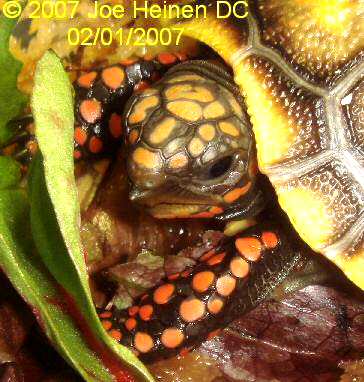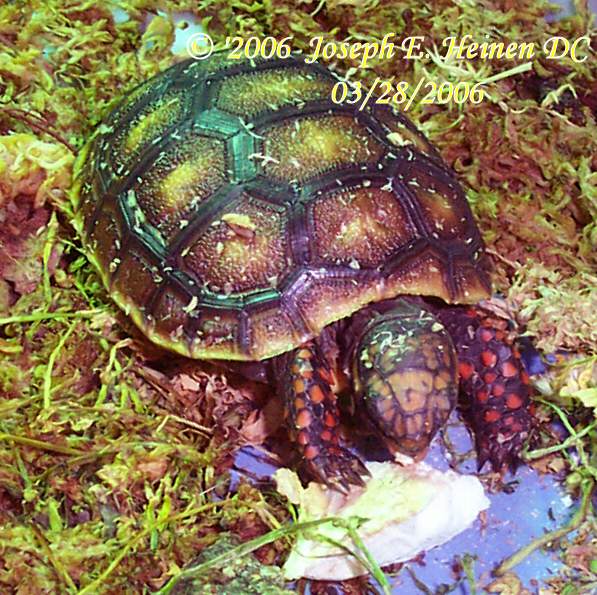Redfoot Tortoise Diet

Redfoot tortoises are omnivorous. They consume both animal and plant material in the wild.
GREENS
Most grocery stores have a decent selection of greens that
redfoot tortoises readily eat. Ideally the greens should be
organic and pesticide free. However this is the real world
and not all tortoise keepers have access to "ideal" food.
So, I have this section as a starting point for a varied
diet. The following greens are easily found in my local
stores:
Romaine
lettuce
Red and green leaf lettuce
Endive
Escarole
Chicory
Radicchio
Turnip greens
Mustard greens
Kale
Collards
Spring Mix (mixed salad greens)
cabbage (on occasion)
VEGETABLES
Yellow
squash
Zucchini
Winter squash
Pumpkin
Carrots (on occasion)
Green Beans (on occasion)
FRUIT
Papaya
Mangos
Apples (be sure there are no seeds)
Strawberries
Blackberries
Cactus fruit
Tomatoes
OTHER GOOD CHOICES
Some other favorites of my tortoises that are available:
Hibiscus
(flowers and leaves)
Opuntia cactus pads
Hosta
Sedum
Mulberry leaves
Hen and Chicks
Ice Plants
Prickly pear flowers, fruit and pads (burn the spines off)
Dandelion
Plantain (not the banana type fruit....the weed plantago
major)
Mallow (flowers and leaves)
Henbit
Rose (flowers and leaves....make sure no systemic pesticides
were used)
Chrysanthemum flowers
Cornflowers
Plagiobothrys ssp
Forsythia (flowers and leaves)
Dayflower
Commelina diffusa
(flowers and leaves)
Californian Poppy
escholzia
Make sure all are pesticide and herbicide free.
MEAT etc.
In the wild redfoot tortoises eat a variety of animal
matter including carrion. Redfoot tortoises fed exclusively
a plant based diet frequently develop hind leg paralysis.
They also have low fertility and hatchlings often fail to
thrive. It is often recommended to feed them low fat cat
food as often as every other feeding. I have found this to
be unnecessary and a contributing factor in pyramiding.
My approach is to feed pre-killed pinkies (new born mice), shrimp, chicken, organ meat, boiled eggs etc. once a month when outside. Here in South Carolina there is an abundance of worms, slugs, pill bugs and other bugs in their pen. My tortoises feed on them on a regular basis. In the winter bugs are less plentiful so I feed animal protein every other week
For the torts I keep indoors over the winter, I also feed Butterworms (extremely high in calcium and great for hatchlings) and superworms.
With the above one can develop a good diet. Once again
(and I can't stress this enough) variety is the key!
Don't feed the same food day in and day out. Mix varieties
and choose a different green as the basis every few days.
AVOID
The following food items should be avoided for a variety of
reasons. there are many books and groups that go into great
detail...so I won't repeat them here. At the end of the page
are a few links).
Iceberg lettuce
Bok Choy
All grains (including bread, pasta etc)
All human food except what's been listed as "good"
Pellet type foods (An often overlooked factor of pyramiding
is grain based diets. These are the pellet food that some
claim to be essential to health. They typically contain soy,
wheat and or rice. These are high in omega 6 fatty acids
which has a negative effect on health. They also have an
acidifying effect which causes a leaching of bone. They are
high in phytate which binds calcium and other minerals. They
also have an unfavorable ca/ph ratio and a low ca/mg ratio
which has a negative impact on calcium metabolism. Grains
alter Vit D metabolism. Diets high in grains can have a
negative impact on bone growth in spite of adequate exposure
to sunshine.
(http://www.sawellnesscenter.com//nutrition/Diet/Cereal%20article-1.pdf)
ANTI-NUTRIENTS
A number of food items contain chemicals that interfere with
a tortoises ability to absorb nutrients from food. Although
most food items have some of these...a varied diet can
minimize the harmful effects.
(more info can be found at
Cornell University Poisonous Plants Informational Database)
Oxalic Acid:
This is a naturally occurring element in many plants and
imparts a bitter taste in greens such as mustard greens.
This substance binds minerals...
the most important being calcium. It binds with minerals
which must be eliminated through the kidneys. In large
amounts (or in small quantities
with improper hydration) can lead to kidney stones and
kidney damage. Avoid rhubarb and beet greens....limit
(don't eliminate) spinach,
Phytic Acid: This is found in high concentration is
peas, beans and cereals. This chemical also binds minerals
as well as proteins.
Tannins:
Although tannins are beneficial for the most part, in large
quantities (as with all anti-nutrients) they bind protein
and interfere with digestion.
Purines:
Purines are well known in humans as being a contributing
factor in gout. Redfoot tortoises fed large amounts can
develop kidney disease.
Goitrogens:
This compound is implicated in the development of enlarged
thyroid glands (Goiters). They interfere with the uptake of
iodine. Some eperts believe that all the Brassicae family
should be avoided like the plague due to this. Limit (don't
eliminate) the quantities of kale, mustard, and other
cruciferous plants.
SUPPLEMENTS
One of the most important supplements is
calcium. If there is a good source of UVB as with
tortoises kept outdoors, a light dusting of the food with
calcium daily is sufficient. Indoors use phosphorous free
calcium with D3. Minerall is a great product with trace
minerals as well as calcium. The main problem with using
calcium powders is using too much. This can lead to bladder
stones and dehydration. Calcium powders can also interfere
with absorption of other minerals such as zinc.
My preferred method for supplying calcium is to feed high calcium food, keep cuttlebone with them at all times and dust food with the TNT® Supplement from Carolina Pet Supply. This is a nutritionally balanced formula which provides the vitamins and minerals that or often lacking in the captive diet. It’s formulated from a variety of dehydrated and powdered flowers and weeds.
|
|
|
|
|
||
They also have wide variety of organic seeds, powdered hibiscus flowers (Roselle) and cactus powder (Opuntia). Both are a natural source of vitamins and minerals.
Also of use is probiotics. Most of our animals come to us with abundance of parasites and disturbed gut flora (the good bacteria that live in the intestines). Supplementing with probiotics goes a long way to restoring normal gut function. iFlora from Sedona Labs is one of the best probiotics used for reptiles.
WATER
Water is very important for all animals. redfoot tortoise
are no exception to the rule. I keep a shallow bowel
of water in the pens. I also flood the pen on a regular
basis. They thoroughly enjoy the mud puddle that the
flooding causes.
Indoors I prefer to use one of those automatic waterers used for dogs. I soak them for 20 minutes in "baby warm" water every 2-3 days. This serves 2 purposes. It allows me to inspect them frequently and (since they usually empty their bowels and bladders while soaking) it keeps the cages much cleaner.
Here are some good links:
USDA NUTRIENT DATA LABORATORY
Oxalic Acid Content of Selected Vegetables
Wild
Edible Plant Nutrition
Chemical Composition of Plants
Plants For A Future - Database Search
University of California weeds
Yahoo! Groups : chelonian_nutrition`
Toxic and Poisonous Plants and Flowers
This Canadian site list poisonous and problem plants. Click on the Latin name for a description.
For help with growing plants for your tortoise, join The Veggie Patch


